...one thing that has been clear for a long time: the program would have to adapt. Things were and are going to change...
Indian National Ice Hockey Team: How it's Relevant
First Indian National Ice Hockey Team, New Delhi, 2009
You may or may not be aware that along with being the founder, Head Coach and Executive Director of The Hockey Foundation, I'm also the Head Coach of the Indian national ice hockey team. Yes...that's right...India has an ice hockey team.
Let's get a few things out of the way here...
While on the surface it may appear to be similar, no, it's not like Jamaican Bobsled (as depicted in the movie "Cool Runnings". Whereas in Jamaica it was a group of men who trained for the Olympics in the US for a sport very much unfamiliar to their nation, in India, ice hockey has been around for about 100 years in the mountainous regions where the game can actually be played outdoors, and we do not compete at a level even close to the Olympics. In fact, we're one of the lowest ranked teams in the world, and that's OK.
The players on my team are comprised of military and civilians. They're respectful, hard-working, absolutely love ice hockey, and come from limited means. Many do not own the equipment that they use, often borrowing from their friends that do not get the opportunity to represent their country in the IIHF Challenge Cup of Asia, a developmental tournament for low/un-ranked Asian hockey nations. Due to the lack of popularity and support for ice hockey in India at large (it's immensely popular in Ladakh, where 90+% of ice hockey in India takes place), the players have to pay their own way in order to play. It's an unfortunate reality. Until the team can garner some sponsors and/or government support (unlikely, considering the significant preference for cricket in India) the players will be expected to pay for themselves, which many can't do, ultimately creating a financial burden on their family and reducing the pool of players available to play for Team India.
It became clear to me a few years ago that coaching the Indian team is not an objective or of The Hockey Foundation, nor is it relevant to the mission. By no means does that diminish the importance I place on having the responsibility to select, train and coach those players. I am honored to have the opportunity to be the head coach of a national team, no matter our performance, and I care deeply for the success of the program and the players, coaches and officials that have been a part of it.
Recently though, it's become clearer how The Hockey Foundation could and should support the Indian national ice hockey team. Prior to and during last year's Challenge Cup of Asia, I had multiple budget meetings with the team, first as the bearer of bad news when I announced how much each player would be expected to contribute, then as the cheerleader, writing and sending letters to local officials to solicit support for their local athletes, then as banker, collecting funds, then again as the bearer of bad news, telling the players that they owe more money due to a handful of avoidable circumstances, and finally as possible ameliorator, coming up with some solution that could potentially help players reduce/recoup costs. This is where The Hockey Foundation comes in...
First, I thought about all of the jerseys being worn by the players. These jerseys would most likely sit in a room for 8 months before being worn again in the following winter by those players that got to wear their nation's colors. But couldn't those jerseys be more beneficial if sold to collectors and/or supporters? Not only would someone be able to acquire a truly rare and collectible piece of hockey memorabilia, but the proceeds would be divided between the players themselves and The Hockey Foundation, as facilitator and mediator in the process. Many of the players wanted to retain some of their jerseys, so I was able to ensure that every player received another set of new jerseys upon their return to India from the Challenge Cup of Asia, which was hosted in Bangkok in March, 2013. Everyone got to retain their memento for playing on Team India, and we all agreed that this was a great way to make back some of their significant financial burden.
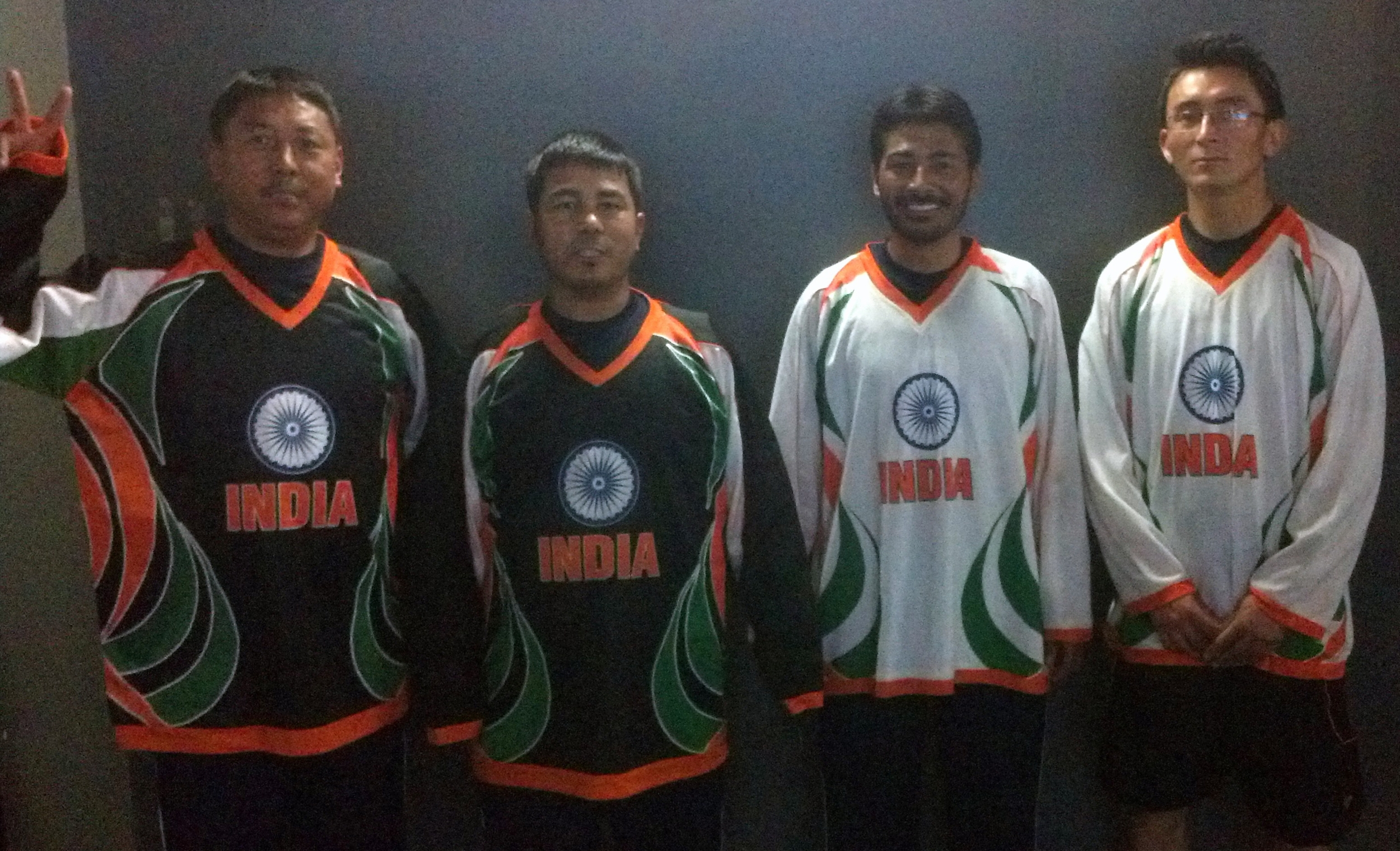
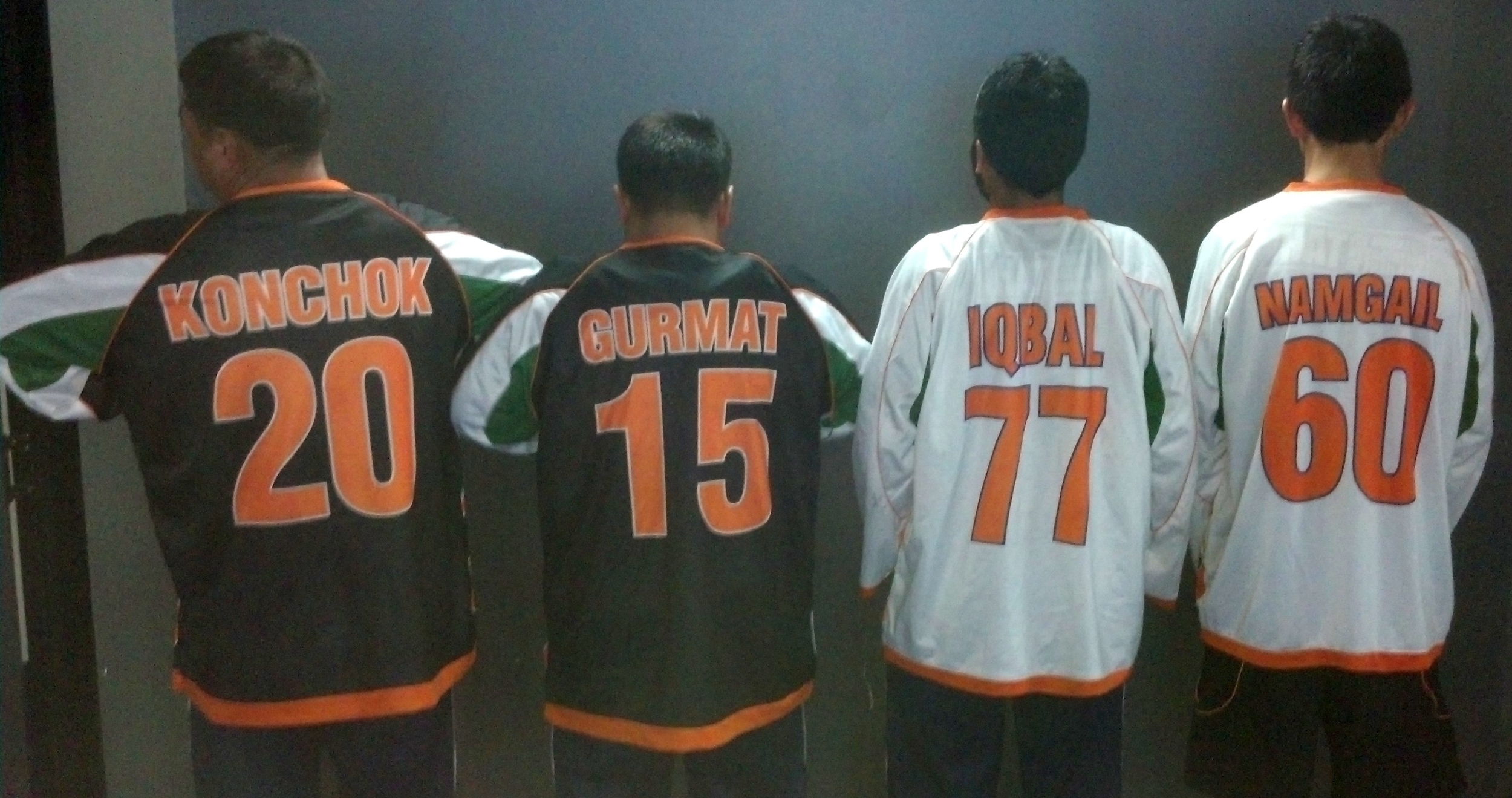
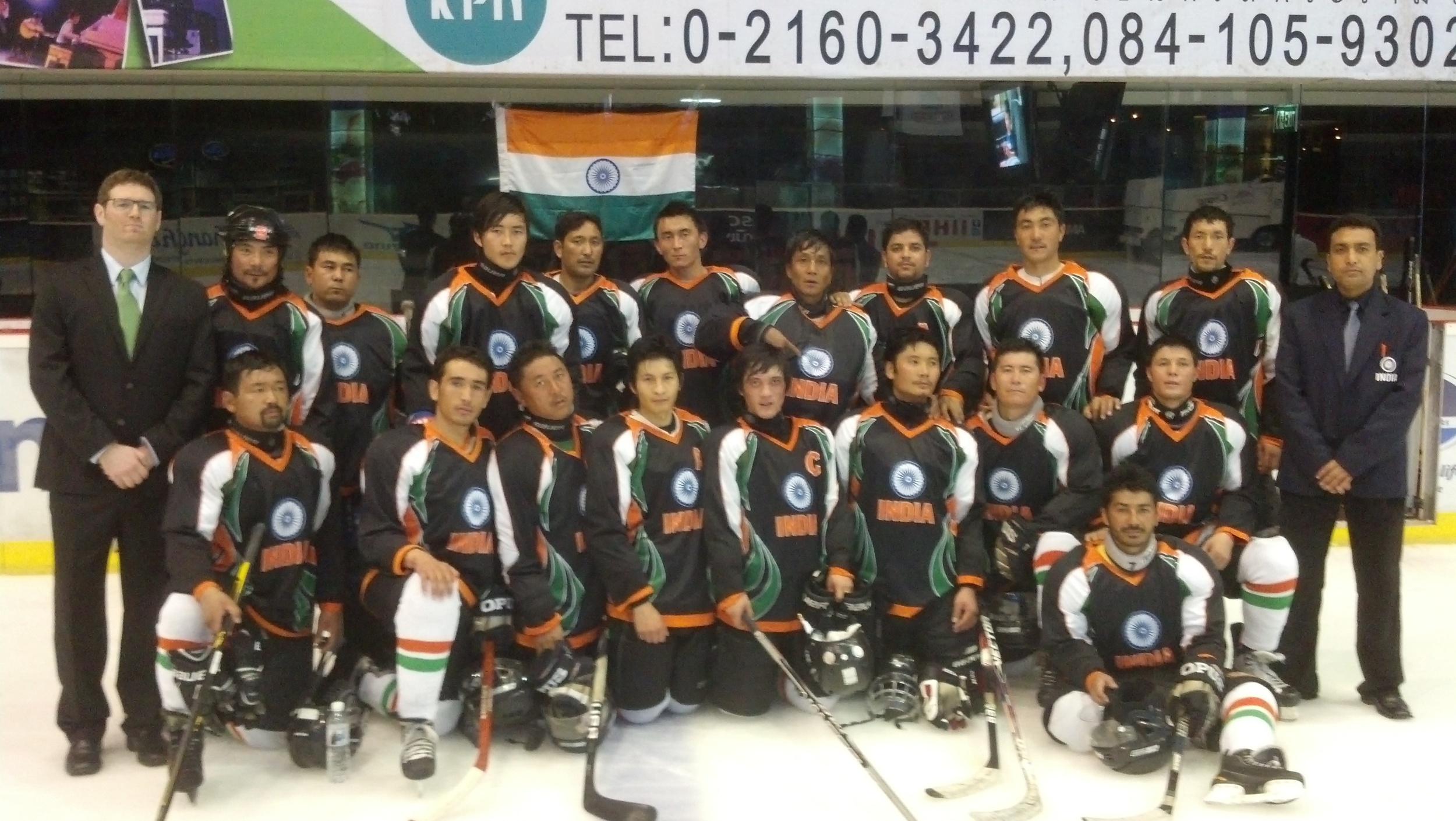
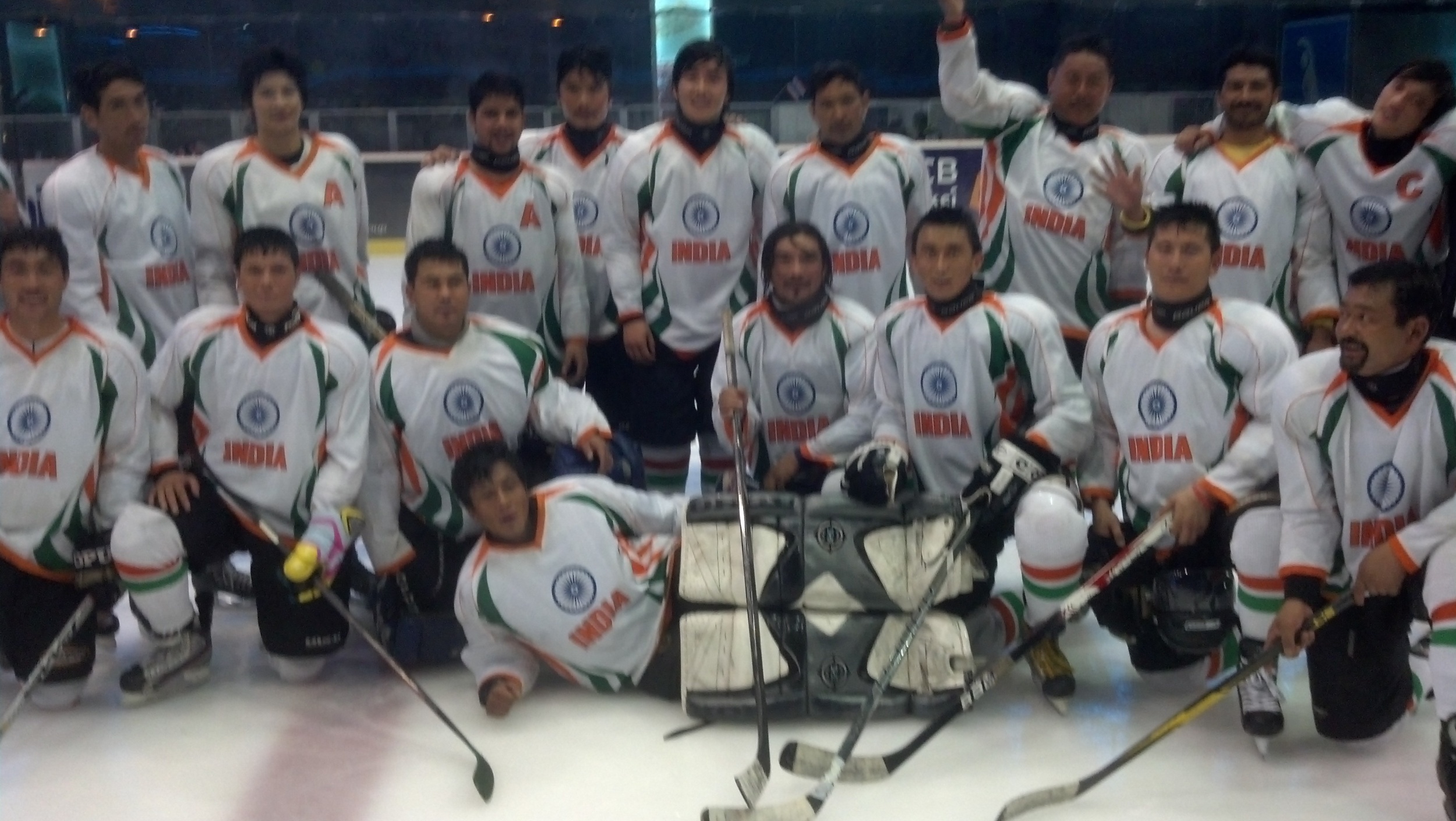
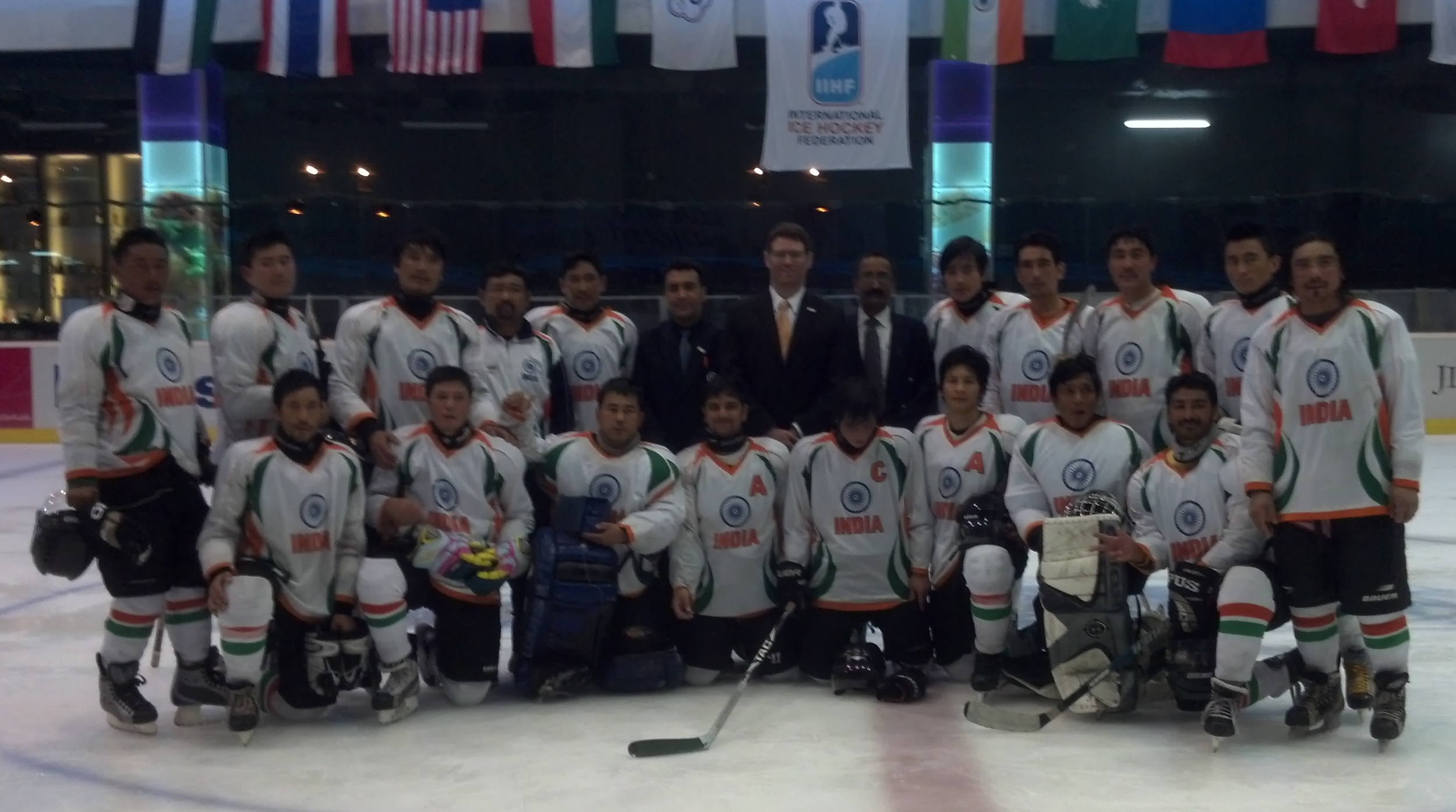


But for those that can't afford a game-worn jersey, the Ice Hockey Association of India was able to have a handful of official Team India jerseys made before my departure from Delhi, with proceeds supporting The Hockey Foundation as a unique fundraising memento.
BOTH OF THESE JERSEYS ARE AVAILABLE FOR PURCHASE HERE
A new plan of action for this upcoming season is to be proactive in the team's fundraising efforts. To date, every player that has played on the Indian national ice hockey team is either from or lives in Ladakh. They are a part of the community that The Hockey Foundation supports in our programming, and many have participated in our coaching clinics. This year, all players have been notified, well in advance, of the expectations placed on them, including the incentive in driving enrollment in our coaching clinics, as we collect a nominal fee for the Ice Hockey Association of India to support the national association's growth and development. The more we raise in India, the more money that can be allocated to the national team, and ultimately less is expected from each player/family. This push for Ladakhis to take ownership over their own success is a major mission of The Hockey Foundation, as Ladakh has an issue with apathy, complacency and a reliance on outsiders to keep on giving money and equipment. We've adjusted our methods for donating hockey equipment due to this realization, and have become more strategic, thoughtful, and collaborative in our distribution of equipment and the expectations associated with an organization receiving our support. It's a constant work in progress, but one I'm happy to undertake and improve.
Although being the head coach of the team is not a part of The Hockey Foundation, I believe supporting the players, the team and the association are, and that support in turn helps The Hockey Foundation. Our organization's are inextricably linked. And I wouldn't have it any other way.
PURCHASE INDIAN HOCKEY JERSEYS
Jullay!
Adam
Hockey in the Himalayas?
(question mark intentional)
So many people seem stunned when I tell them about ice hockey in India. Adding in the explanation that it takes place in the Himalayas makes it both more logical and more alluring, all at the same time.
The most common comparison people make is to Jamaican bobsled (popularly portrayed in Cool Runnings), and on the surface it's easy to understand why, as both countries are primarily tropical and the associated sports are not native, and not easily performed, within the respective nations.
But that's about it.
While bobsled was a sport that a handful of Jamaicans were able to undertake and compete in, ice hockey is growing in popularity in India, especially in Ladakh, a remote region in the state of Jammu & Kashmir, which is sandwiched between Pakistan and Tibet (China). It's also being played in Shimla, in the neighboring state of Himachal Pradesh, on and off in Dehra Dun, the capital of the state south of Himachal, Uttarakhand, and even at a small indoor facility on the border of New Delhi and Gurgaon (Gurgaon is kind of like the Bangalore of North India...corporate parks, call centers, suburbia, middle class & upper class boom, trendy clubs, Western restaurants, and many many malls).
Hockey has been played in India since the British introduced it in the early 1900s (in Shimla), and has been growing in popularity in Ladakh since the Indian military brought it with them in the 70s. Today, hundreds of Ladakhi children and adults play hockey for 2-3 months every winter, when temperatures in the region are consistently below freezing. Schools are off during the winter, and tourism is low (other than people trekking the Zanskar River), so hockey has become the literal pastime, the sport that passes time. But it's become more than that. It's become a way of life, as so many Americans, Canadians, Swedes, Czechs, Russians and more can understand.
We've interviewed children (boys and girls) and adults about what hockey means to them, and the answers are wonderful. So many of them remark that hockey has given them confidence, it's allowed them to work together better as a team, it makes them happy, it keeps them healthy. One women, in particular, said she's happily married to hockey.
This love of the game can't be tought, it can only be noursihed. The Hockey Foundation strives to not only nourish that love, but to focus the understanding of the game, and to reinforce many of these qualities that so many intrinsically understand once the game captures their hearts and minds.
We strive to teach not only the young players, but the organizations that ultimately interact with them every day, that they need to work together (organizationally, regionally, nationally), that they need to be accountable for their actions on and off the ice, responsible for their own success, that they need to be resepectful, humble, yet confident, that they need to be tough when necessary, but gentle otherwise, and that they need to have fun!
It's not easy to survive a winter in Ladakh. There's very little indoor heating and running hot water. It's cold, all the time, everywhere. You see your breath when you sleep, you have to use buckets for showers, and bathrooms are either outside or the ones inside don't flush. There are very few options for food, and not much in the way of entertainment, but there is hockey in one of the most beautiful mountainous regions of the world, with a vibrant history.
Resources are limited though. Coaches are few and far and getting equipment is both difficult and expensive. The Hockey Foundation's coaches go with great expense to themselves, not only to travel to Ladakh, but the time away from home not taking in income. It's a burden in many ways, but one we all feel a calling to undertake. We also bring as much equipment as we can transport with us, in addition to any equipment we ship to India through the year (more on that in another post). In the past 5 years, The Hockey Foundation has donated 300+ pieces of equipment throughout Ladakh (Leh and Kargil Districts) and we've coached over 500 children and adults. This year is looking to be another record-setting year in all measurable categories, and it's with your support that this is possible, so thank you to all that have donated, and to those that have helped in countless ways!
Adam
The Plan, Part 4: Barely in Bodhkharboo
It only took five days longer than expected, due to snow storms, but eventually we made it to Bodhkharboo. Only problem: more snow was forecasted throughout the region, from Kargil to Leh (Bodhkharboo is in between them), so the decision to stay was long and arduous, with multiple incarnations of stay and go proposed.
Ultimately, at the request of the General Secretary/President of the Kargil Ice and Snow Sports (KISS) I agreed to stay for two days, as he guaranteed that the weather would hold to get me back to Leh in time to continue my adventure. He is a very determined man, so it doesn’t surprise me that he would promise something he can’t control.
The next morning, the rest of my group agreed to stay as well, which included Paul and the two girls from mainland India that were also volunteers at SECMOL and had the fortunate/unfortunate (depending on point of view) opportunity to be my stand-in translators. Alex had made it out of Drass just before the storm hit, so he could not join us in Bodhkharboo. His support on the ice and behind the camera was invaluable. I look forward to sharing more experiences like this with him in the future.
From the outset, there were supposed to be seven days in Bodhkharboo. At the conclusion of that camp, I was debating heading to Dhomkhar, but scrapped that plan when it became apparent that 1) the “Under-16” players from Dhomkhar were not actually under 16 (it has since been learned that they are reasonably open about the fact that they cheated, although I’m not sure they consider what they did cheating), and 2) they won the Under-16 tournament in Leh. My goal in Ladakh is to help the players that need it most, but also reward the players that show integrity in their actions. Our tour around Ladakh was decently publicized in newspapers and radio around the region, so I hope the players in Dhomkhar are aware that they were purposefully ignored in our hockey clinics this winter. When it gets announced next year that we are returning, I hope that they request our support so we can explain why we didn’t give it this winter.
After the scheduled hockey camp in Bodhkharboo, the region quickly warms up to the point where it’s nearly impossible to skate. Bodhkharboo is close to Chiktan, where I participated in a tournament two years prior. I loved the scenery and the people in this town, but the ice quality was terrible two years ago (it was like walking on broken glass in ice skates), and was even worse this winter. As a result, the camp was hosted in a town that had never played ice hockey before.
Before our arrival in Bodhkharboo the Kargil Ice & Snow Sports Club hosted a learn to skate program that was run by Stanzin Dolkar, a Ladakhi woman that was featured in a documentary Thin Ice, that focused on a particular controversy surrounding women’s hockey in Ladakh, and the girls at SECMOL. Having spent enough time around people involved in this controversy, I will spare you any more details and depositions and let you see the documentary on your own and go from there.
Stanzin Dolkar has had a particularly unique life for a Ladakhi. She’s well-traveled, having gone to Sweden for the documentary, Finland for an IIHF training on behalf of India, and Malaysia to participate in hockey training on behalf of India as well. She’s got a firey personality, is quick on the sarcasm, and has a big laugh that can make anybody with half a heart smile. She’s got a toughness that many Ladakhis, let alone Ladakhi women, lack. As a core ideal of The Hockey Foundation, toughness is a quality that’s important on the ice and in life, and to see someone like Stanzin Dolkar have that quality is refreshing and gives me hope that we can continue to make progress with the rest of Ladakh. The goal isn’t to tell them how to live their lives, nor is it to change their culture. On the contrary. The goal is to help them strengthen their culture and quality of living, on their terms. Ladakh was closed off from the world for most of their history, and the recent modernization has started to eat away at Ladakhi culture, not just Ladakhi tradition. Local politicians have started saying the same thing, that Ladakh is losing its tradition on its own. The foreigners that come to Ladakh come because it has a deep tradition that has remained consistent for centuries, if not 1000 years. They don’t come to modernize Ladakh. It’s the ruggedness and tradition that is appealing, and although Ladakh is moderning, it is far from modern.
Stanzin Dolkar hasn’t been involved in hockey in Leh as a result of the Thin Ice controversy. The opportunities in hockey have been given to her by the Ice Hockey Association of India and the Kargil Ice and Snow Sports Club. It’s unfortunate. She has so much to offer the hockey players around Leh. Hopefully things can progress to a point where bygones are bygones and everybody can get back to focusing on the improvement of hockey and the betterment of the children.
Stanzin Dolkar - I refer to her by her full name because Ladakhis don’t always go by the first name, nor do they always go by the last name. It seems to be a random application of the names, more so than in the West. Since there are as many Dolkar Stanzins as there are Stanzin Dolkars, I prefer to follow the other form of the acronym: “KISS”, Keep it Simple Stupid - had to hold learn-to-skate lessons for extra days due to us being stranded in Drass. When we arrived, the first thing we did was check out the ice rink that was claimed to be to international standards. They were not (no surprise there). The rink was a fraction of the size that was claimed by the head of KISS, there were no boards, the ice was beyond choppy, and oh yeah, there were no goals. You know…minor details.
Another problem facing the players in Bodhkharboo: poor skates. This has been a problem throughout Ladakh. We thought it was bad in Drass. It was much worse in Bodhkharboo. Children were wearing enormous skates with dull edges on poor ice. We weren’t able to coach more than 20-25 people at a time, and even though that’s ideal in North America, we can usually accommodate a few more in Asia. Overnight they built some hockey goals for us to run a learn-to-play program, as intended. Unfortunately, since nobody in Bodhkharboo had ice skated previously, this was just a continuation of the learn-to-skate program that Stanzin Dolkar ran before our arrival.
We did end up running some passing drills to at least make it appear that it was a hockey clinic, but these drills were performed with incredible difficulty in comprehension and execution. The concept: pass to the player across from you, then skate to where they were standing. They will do the same to the next person in line, and so on. Got it? We had to do this drill for two days, and it still wasn’t close to done well.
Separate from the educational limits, there was only 1 player on the ice other than myself and Paul that had a hockey stick that would be considered adequate. Some players had sticks that were 2 feet shorter than they were. Other players had sticks that were heavily taped together to keep it in one piece. Some players had hockey sticks constructed with local wood. They were not tempered, so had lots of flex and minimal support, and the blade was rarely curved more than 1 cm, and to make matters worse, was a separate piece of wood that was usually nailed and wrapped with twine. This is arguably the most important part of the whole stick, the base of the shaft near the heal of the blade, as most sticks break here due to the shock and vibration when passing and shooting (or slashing in some cases). These days, wood sticks are usually fused together by blending with plastics and composite materials and are tempered to the point where it becomes one piece. If the shaft and blade are in two pieces, all the vibration in the blade will stop at the nails and twine, limiting the stress the hockey stick can handle. I tried to explain this to the guy making these sticks. He responded with a blank stare.
The biggest problem during the passing & skating drill was that most of the passes were significantly off. Usually the passes were 10 feet wide, which is where another player in line was standing. I would not accept that their shotty sticks were the culprit, so I traded sticks with a player and showed them that even a local stick can give and receive accurately, and that their local sticks are sufficient to execute a drill properly. They still couldn’t control their passing, so I gave each group an ultimatum: 3 large mistakes as a group and the next one goes. Keep doing it right, keep practicing. This was a pretty effective shift, instead of just letting each group go for a set time. It motivated them to pay better attention, try harder and assist the players that were struggling.
Since our time was limited, I ran a classroom session after the 1st practice. I spent an hour, translating through Stanzin Dolkar, explaining the rules, penalties and basic concepts of the game. Some of the kids were great, asking detailed questions about scenarios, while others laughed and dozed off. They got one warning, then they were kicked out. 30 minutes in, I gave them an opportunity to leave as a group, so the youngest took that opportunity, which is sad in one aspect, but considering it’s the older ones that will teach the younger ones, it’s fine by me.
Ultimately, it’s unfortunate that we weren’t able so spend more time in Bodhkharboo, but there’s also a frustration, considering we were promised a particular scenario about the condition of hockey in the area that was not true at all. The clinic was not for beginners, it was for children that never set foot on the ice. It’s the beginning of being beginners. Hopefully though, this was enough for them to take notice and start playing every Winter. Considering the fact that Bodhkharboo is pretty remote from the major cities of Ladakh (Leh is 5 hours, Kargil is 2), it’s definitely something for them to do in the harsh Ladakhi Winter. This was also an incredibly beautiful area, with mountains practically on top of the rink, which was a 3 minute walk from some pretty steep cliffs. It was also one of the last Buddhist towns heading towards Kargil, even though it’s in Kargil district, which is predominantly Muslim, which makes it quite unique for the region. There’s a feeling of being at the crossroads of Ladakh.
I look forward to spending a proper amount of time there next Winter.
Time Flies
It’s been two years since I was last in India & Ladakh (in many ways, they are different worlds, even though Ladakh is a part of India). It’s a surreal experience. I spent three and a half months in India in 2009, of which 5 weeks were spent in Ladakh. Other than New York, there’s no place on Earth I’ve spent more time. It’s something I never would have imagined, even as I was preparing for my first trip here. When I returned home, it was obvious Ladakh & the rest of India left an undeniable mark on who I am as a person. It was upon arriving in India again that it became so apparent.
Upon landing in Delhi, I borrowed the phone of the gentleman sitting next to me, still on the tarmac, and called a friend to see if I could stay over for the evening. It was no problem, as I suspected. That pattern has continued thoughout. My plans have consistently been last minute, yet always worked out as I intended. With so much to do, I’ve scheduled very little, knowing that it will all play out as it should, as long as I follow up with the right people the right way. When people have asked me what my plans are tomorrow, next week, or next month, all I can do is shrug and say “I don’t know”, even though my agenda of tasks to complete is long and under way. Everything progresses as it must. In response, Americans, Ladakhis and Indians have all said the same thing: “that’s very Indian/Ladakhi of you”. All I can do is agree. Twenty months wasn’t going to diminish that characteristic. If anything, returning hightened the desire to operate in a state of controlled chaos.
I spent a long time upset that I couldn’t return to India last year, as I promised upon departure in 2009. For simplicity’s sake: it wasn’t feasible for me to return to India, financially and emotionally. The previous trip went much longer than expected, and the road to recovery was also longer than expected. At the same time, there were factors that held the organization back and other factors in India that made it less enticing to return. That’s the short of it. For a while, that was it.
But things started to change in life, for The Hockey Foundation, and regarding ice hockey in India. Finances stabilized, the organization got a new identity thanks to Kevin Sterling working with me to develop a new logo, and I got news that the arena in Dehra Dun was finally completed. From there, all it took was the support of the companies I work for, and the businesses I work with, and 8 weeks after making a decision and 5 weeks after making that decision public, I departed for India on the same date in 2011 that I did in 2009, only this time with support.
Alex Harney has joined me for the first leg of this trip, recording pictures and video of our work here. Alex played hockey throughout his childhood, has a background in photo/video, and is a great guy that is as passionate about this project as I am. He’s already in love with Ladakh! I’ve been delighted to introduce him to my friends in Delhi and Leh, and he’s been able to record what has made this experience so surreal for me.
In so many ways, it’s like I never left, and everything feels like home. The excitement of going somewhere new has been replaced by the familiarity of Delhi and Leh. At the same time, there’s a much greater sense of purpose and confidence that focuses my intent and allows me to enjoy things in a whole new light. The familiar is raw. And that’s India…raw. Everything flows as it should, and people and situations thrive where others never could.
The situation is a bit different this time. Last time, I came without an understanding of hockey in India & Ladakh. Now that I have immersed myself in it, there’s a lot more to do and a lot more to tell you about. Future posts will give you an understanding of what we are here to do, what has been going on from our side of things, and what others are doing to support hockey in Ladakh/India. There’s a lot, so I’ll save it for now.




